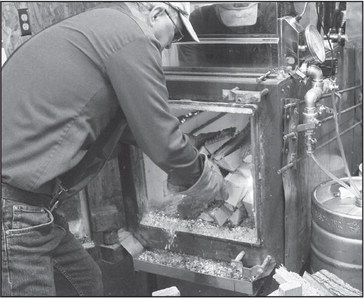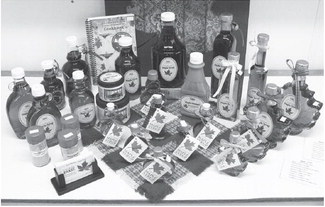MAKING THE MOST OF MAPLE


Greenwood sugar shack known for sugar, creme and mustard
Larry Pakiz wasn’t thinking very far ahead one spring day some 15 years ago when he was walking through his yard with a cordless drill in his hand and figured he’d see what happened if he poked a hole in a maple tree. Well, how about that? Sap came out, he saw.
After finding a piece of tubing to tuck into the hole and hanging an ice cream bucket on it, Pakiz watched as he soon had a gallon of the sugary stuff. A true, stereotypically stingy Slovenian, Pakiz said, “Man, I can’t waste this,” so he proceeded to collect more sap, tapped a few more trees, and cooked it all down in a sheet cake pan on his propane grill.
“By that night,” Pakiz recalls with a grin, “we had a half-cup of syrup and an empty propane tank. I said, ‘That’s kind of an interesting hobby.’” Pakiz didn’t know yet what he had started, but that first maple tree tap was only a few yards from where his sugar shack stands now, complete with a modern electronically regulated evaporator, home-built gravity-fed supply system, and an end-product line that includes not just pure maple syrup, but maple sugar, maple creme and even maple mustard. He’s found out how to profitably turn a maple tree’s lifeblood into sweet swag, while scratching the itch he’s always had for using his mind and hands.
Pakiz and his wife Sue live a few miles southwest of Greenwood. Both retired now, they spend a month or so each spring in the sugar shack just behind their home, stoking the wood fire that boils thousands of gallons of raw sap down into syrup. About half the sap they process is purchased from friends with maples, and the rest they haul in from seven miles away on a friend’s land.
This year was a decent one, as sapping springs go, with 300 gallons dripping from their evaporator into waiting barrels. Their best year so far was 2018, with 508 gallons of finished product.
After using an undue amount of propane to cook down that first sheet-cake pan full of sap, Pakiz built himself a small wood-fired cooker and busied himself each late March and April with making enough syrup to use on his breakfast table and give some away.
“I vowed I’d never sell a quart,” he said back then. “This is just a hobby, Larry.”
Engineering and tinkering are also hobbies, though, for Larry, and soon he was reading on the Internet how he could expand his small operation. By 2013, he was in much larger production mode, with a hand-welded wood stove, large evaporator with bells and whistles such as electronic temperature read-outs, and a supply system that lessened the manual labor load.
Most of the system is home-built, with Larry doing extensive research to make what he needed. He either fashioned his own parts out of materials he bought, “or copied from someone else who previously did,” he said.
The Pakiz property is only about two acres in size, and Larry has just a few maples he planted years ago. But a friend — the late Steve Bushman — had a prime sugar bush just seven miles away, and he and Larry took the gravity tubing knowledge Larry had gleaned online and turned it into a working sap system.
Bushman’s land was sloped ideally for stringing vacuum collection lines between approximately 180 trees. They must be individually tapped each spring, but a pressure system powered by an old bulk tank pump draws the sap from the trunks into a collection point. The sap fills large plastic tanks, which are then hauled back to the sugar shack.
At the shack, Pakiz has three old dairy bulk tanks that can store 1,650 gallons of raw sap. It comes in from either the Bushman land, or from a few landowners in the area who also collect sap and sell it to Pakiz.
Another pump at the shack draws the sap from the storage tanks into a head tank that sits in the upper level of the shack. From there, it is gravity- fed into a float box on the evaporator, which draws down more sap as it is cooked down.
Larry said the sap season usually runs about 5-6 weeks, depending on a given spring’s weather. This year’s was a tad shorter, with warmerthan- average temperatures coaxing the maples into early budding mode.
“When the trees bud out, you’re done,” he said. “They make funky syrup.”
During the sap season, he and Sue and other helpers will cook from 15-18 days. A good day’s collection will yield perhaps 1,000 gallons, and the evaporator can turn about 90 gallons of sap into syrup every hour. Obviously, the cook days get long.
A main chore on cooking days is feeding the voracious fire under the evaporator. Temperatures in the firebox soar past 2,000 degrees, Pakiz said, and even the smoke churning out of the chimney is still at a searing 850 degrees. Pressurized air forced into the firebox ensures there’s enough oxygen for maximum heat.
Pakiz uses slab wood he buys from a nearby Amish sawmill for his fuel. He’ll buy 15-18 bundles a season, and burn through a bundle in a good day. With the firebox chewing up a load avery 15-18 minutes, it takes constant monitoring to keep the system moving along at the right levels.
If the temperature in the final stage gets too hot, the syrup will scald the stainless steel guts of the evaporator.
“If you’re not here, you can have junk pretty quick,” Pakiz said.
The sap entering the float box is about 35-40 degrees, and it needs to get to precisely 218.3 degrees at the end stage to drip out at just the right consistency. Just a variation of as little as one-tenth of a degree makes it too light or too heavy.
Pakiz floats a hydrometer in syrup samples to test it for the proper specific gravity. An auto-draw system allows the finished sap to drain out into a waiting barrel. In the olden days, he said, syrup makers dipped a spatula into the syrup and watched how it dripped off to know if it was ready.
The Pakiz syrup is stored in barrels until it is processed into various products. It still has to go a reheating and filtering process so it looks perfect in a clear glass syrup bottle.
“You can’t have a speck of anything when somebody pours it on his white plate of pancakes,” Larry said.
Once the Pakizes started producing enough syrup to make it a financial asset, Larry said he and Sue discovered new uses for it when attending an exposition in Pennsylvania. One of the sessions they attended introduced them to the process of refining the syrup into sugar, creme and mustard, and they brought those ideas home and began to experiment. This year, about 250 gallons of their 300-gallon total production will go into products they will sell, with the rest to be sold in bulk or to a bottler.
Sugar is the main component of maple syrup, and the more moisture one pulls out if it, the more concentrated it becomes. Making sugar or creme or mustard starts with bringing the sap closer to a solid form.
“They all involve reheating and drawing more water out,” Larry said.
For the sugar, the sap is boiled down in what Larry said is a quite amazing process of removing almost all of the liquid. What’s left in the end is granulated maple sugar, and they mix that with various ingredients such as cinnamon to make a variety of sugar products that they package and sell. For creme, the sap is also boiled down and processed in a machine that converts it to a buttery-consistency for spreading on bread or other foods. For the mustard product, the sap is thickened and combined with typical yellow mustard and bottled.
Larry said the mustard is their biggest seller, largely because it’s not a common product locally. The sugar is the next best seller, with sales of regular bottled syrup ringing up the fewest sales, because there’s a lot of competition.
“It’s tough to sell liquid syrup,” Larry said. “There’s a lot of people making it. That’s why we started out with the mustard and sugar.”
Another reason Larry said he and Sue went into refined products is the ability to generate more income.
“Of course, there’s a lot of work to get it from the barrel to the bottle,” Larry said. “In a typical year, there is probably 50 to 75 hours of additional time” to make enough product to sell at five or six festivals, including the Maple Fall Fest in Marshfield, the Thorp Pumpkin Festival and the Taylor County Lions Cub Spring Fest, among others.


